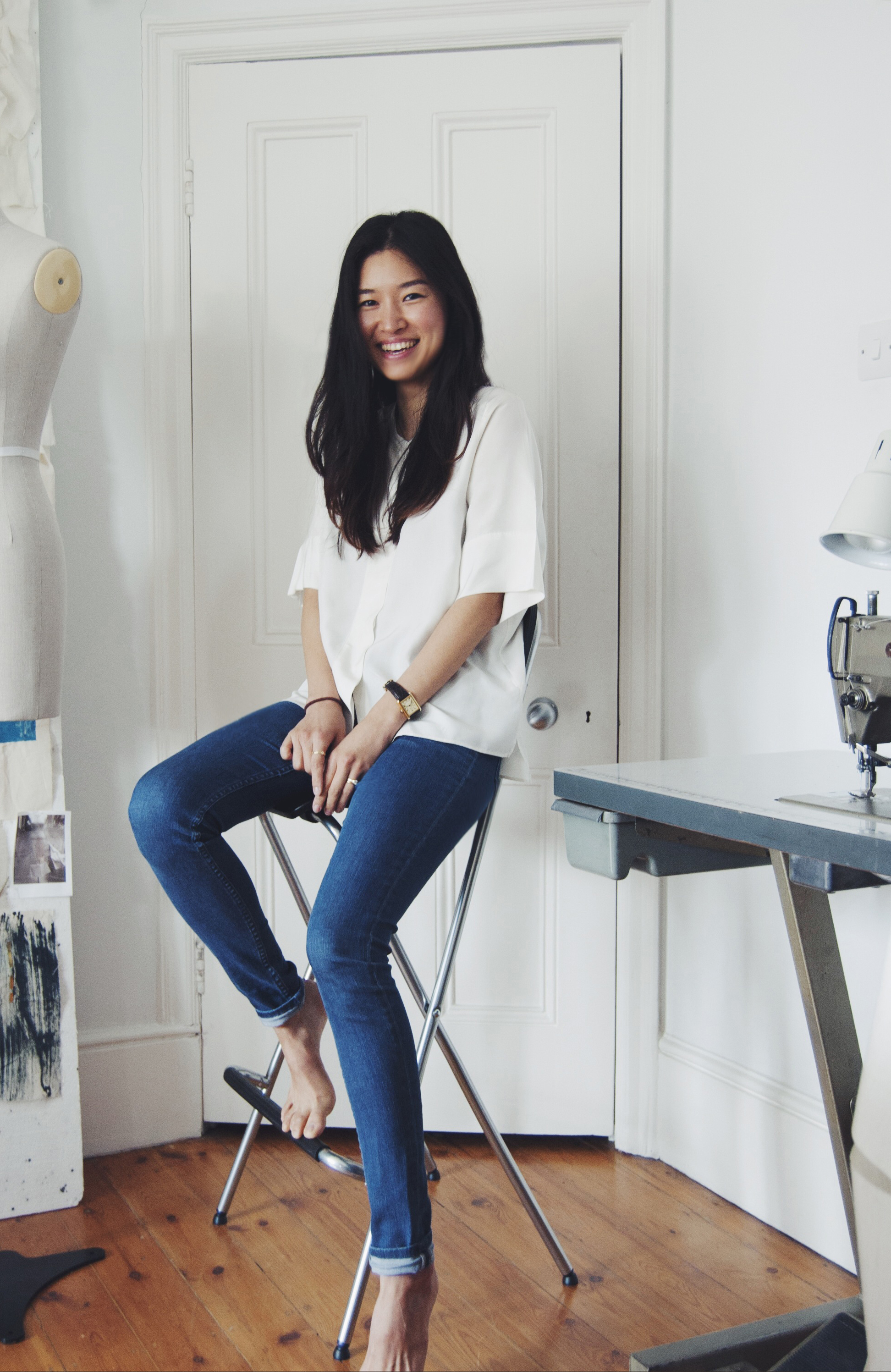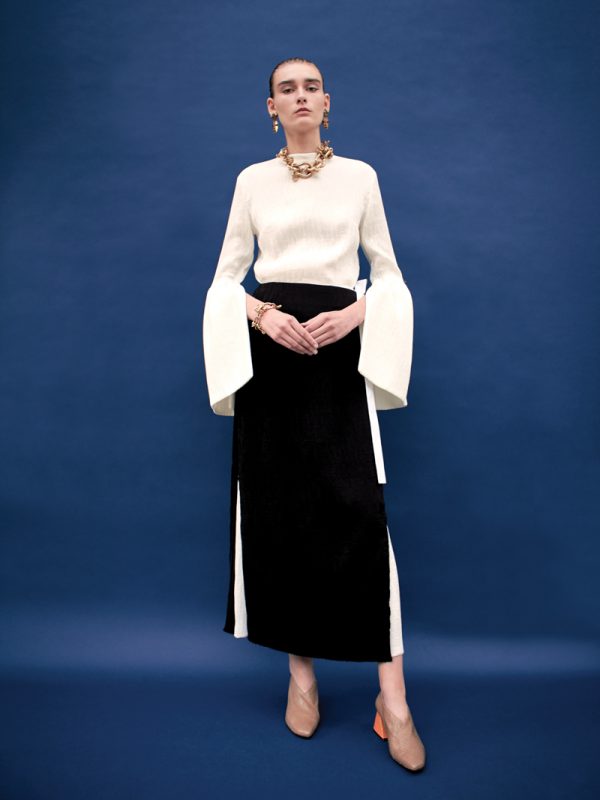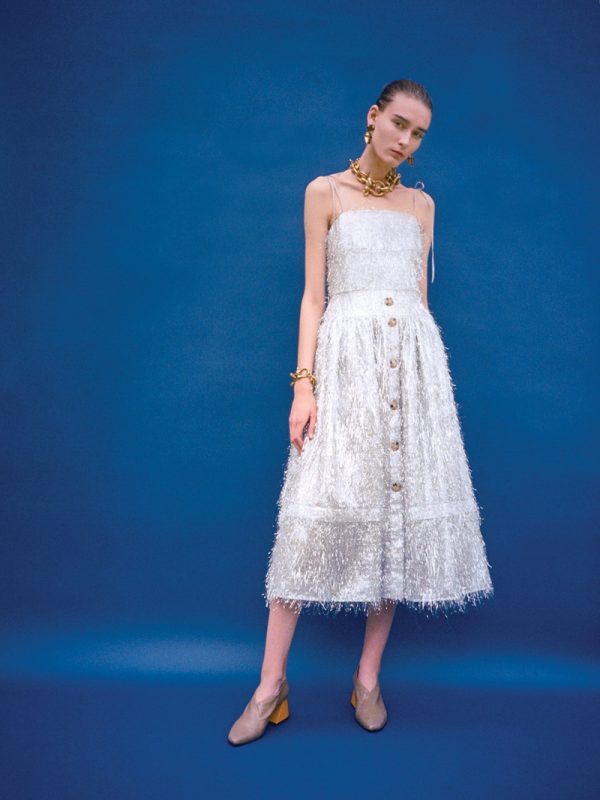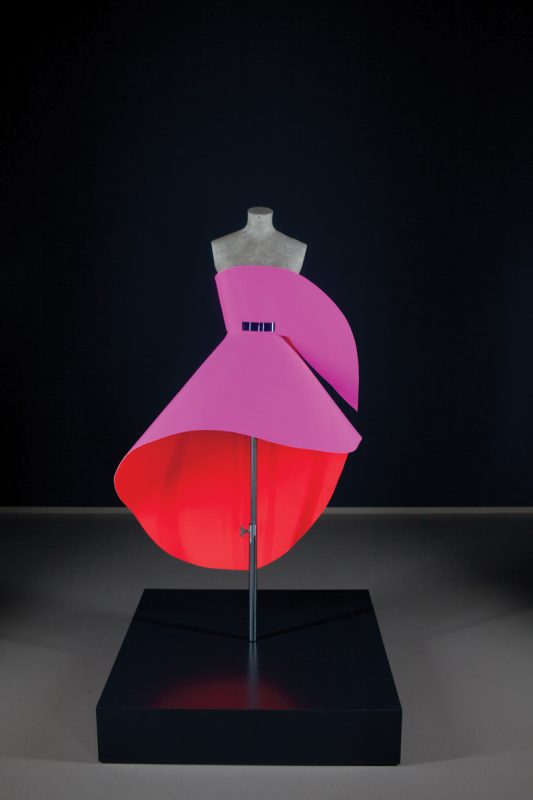Sheer determination and some parental pestering landed the Korean-born Rejina Pyo at London’s prestigious Central Saint Martins. After a brief stint designing under Roksanda Ilincic and her own exhibition at the Museum Boijmans Van Beuningen in the Netherlands, Pyo launched her eponymous label three years ago. Since then, Pyo’s designs have gained a loyal following with influencers like Kate Foley and Leandra Medine, who rely on her elegant, feminine, and thoroughly modern collections to cut through the streetwear noise.
What is your earliest fashion memory?
My mom worked in fashion in her early twenties, so she had sketchbooks and things like that around, but she didn’t want me to do fashion. She would try and hide the books from me, but I would always find them and try to draw the same things that she did. She made a lot of my clothes when I was young, as well as curtains and cushions and other things, so I asked her to teach me how to use the sewing machine. I made my first dress when I was 13. It was a check fabric, and I was so proud that all the lines matched up.
You attended Central Saint Martins. What did your mother think when you decided to go to fashion school?
First, I went to art school in Korea, and after I graduated, I got a job. It was really different from what I imagined. I just really wanted to go abroad. I told my parents that I didn’t like my job and I wanted to go to Central Saint Martins, and they told me, “Your first job is always hard. You just have to stand up to it.” Eventually, my mom told me that when she was younger she wanted to study abroad but she couldn’t. She didn’t want me to regret not going, and she didn’t want to be blamed for it. [Laughs] I applied for the master’s degree and I got in, and they allowed me to go. While I was in London, I met an Irish guy and I got married, so I ended up never going back. My parents were a bit upset that I never came back, but they are happy that I’m happy. It was the best decision that I ever made.
What did you do after graduation?
I wanted to work in London, but, of course, when you graduate, you suddenly start to see the reality of things. I wasn’t a U.K. citizen, and I needed a certain visa. Companies need a lot of money to support visas, and so oftentimes they don’t want to hire international students. It was really hard, but luckily I got a job thanks to my professor, Julie Verhoeven, and then later I got married. Julie was friends with Roksanda [Ilincic], and when she saw my work she thought we shared a lot of the same inspirations. I had never worked for a small studio-based company before. In Korea, I was working for a corporation where I wasn’t able to see the whole process. I learned a lot seeing the bigger picture in an open studio. Then I won this opportunity to do a full-on exhibition at the oldest museum in the Netherlands. At first, I spoke with Roksanda and I thought I could do it at the same time while working on the weekend. Then I visited the museum and it was a bit like the Tate Modern, and they had given me this huge room. I realized that I was going to have my name on this, and I wouldn’t be able to dedicate 100 percent to both of them at the same time. Roksanda said, “Of course you should do it.” I worked on the exhibition for six months. I had so much fun. It was like making sculptures, which I’m also interested in, but as a fashion designer, you never have the luxury to work on something without thinking about whether or not buyers will like it. After that, I had some prize money and, of course, I wanted to do my own line, so I decided to do it when I’m young and have some energy!
What was your first season like?
I made a capsule collection, but I didn’t really know anything about when to meet buyers or all the fashion cycles. Luckily, Harvey Nichols picked up my first season and it sold really well. Slowly, it grew and three years later, it is what it is.
Net-a-Porter picked you up for Fall ’16. How did that change the business?
Actually, Net-a-Porter wanted to pick me up the first season, but at the time, they were launching a capsule collection that had similar color combinations, so it didn’t work out. But the buyers were really supportive and wanted to buy a lot of my pieces for themselves. When it launched for Fall, they sold through over 50 percent. They quickly placed a reorder because the stock was gone so quickly. Just being on that bigger platform was great, because you work so hard on the collection every season and you really want more people to see it.
Where do you produce the collection?
In Europe and the U.K. initially, but for buyers in the U.S. it was 30 percent more expensive by the time they imported it. I found out that Korea has a free-trade agreement with the U.S. Because I had been working in Korea, I have a good relationship with the small ateliers through the company that I used to work with because they do high-quality products. So we hire people for quality checks and ship it directly from Korea to save on duties, which keeps the prices down. We will continue to do that unless Trump changes things. It was quite funny working on the importing documents! As a designer I’m not meant to do these sort of things, but it’s good to learn about it. We still control the quality on each piece because we are small enough to do so.
What have you learned about your customer since you started you business?
When you start, you’re basically satisfying yourself without really thinking about who’s going to pay this amount of money and who is going to wear it and when. I learned a lot. Not everyone can afford to buy designer clothing for $2,000 or $3,000 and even if you could, you probably aren’t going to wear it every day or wear it to work. There are other brands that offer more of a streetwear style, but they’re not necessarily sophisticated or feminine, and they’re often not at an affordable price. So I thought there was something missing in the market. My client is a normal woman who works, gets a salary, and wants to buy something for herself. She’s not someone who has tons of money and buys everything and wears each thing once. I really want to make sure that my pieces have a timeless element to them. I want them to be able to survive in your wardrobe for quite some time.
Who are some of the women who have been wearing your clothing?
Leandra Medine, Kate Foley, and Pandora Sykes—they are intelligent women with confidence in themselves. They know what type of shapes suit them. They’re not just wearing something because a magazine says it’s a must-buy this season. We also have our own online shop, which is a treasure to us. It’s just amazing to see someone ordering from us in India or Sweden. Sometimes I look them up and you can see that they’re a product designer based in Stockholm or other interesting jobs and you can really picture them as a real woman. When you are selling to retailers you are usually just delivering a certain amount, but you never get to see the customer. But when I do go to the stores and speak to the assistants, they tell me my customer is a girl between 20 years old to a 60-year-old woman, who picked up one of my skirts. I think that’s a big asset to have that wide of a range of women wearing our brand.
What have you been working on for Fall 2017?
Because of the Internet, there are so many brands that are coming and going. Most importantly, you need to keep your identity. There is nothing more shameful than to keep changing your style after clients are just starting to recognize you, so it’s really important for me to keep the same aesthetic and design elements so that people can always recognize that it’s Rejina Pyo. But I want to continue to add new elements to it. I was working really hard to get that balance this season because last season a lot of dresses were worn by celebrities and fashion editors. You can’t just keep doing the same thing, but on the other hand, people want it now because they’ve seen it on those women. You have to be somewhere in the middle. It doesn’t work to design items just because you think other people will like them. The best instinct you can have is your own.
How do you hope to see the brand evolve?
We are a very small team, so one day I hope to have more proper departments. When something happens now, we all have to work together. I’m very thankful for the team that I have. They are all very thoughtful and caring, but maybe one day they could have more of a break! I would also love to design other elements, like shoes or jewelry. We’ve done shoes and sunglasses through a collaboration, but we haven’t done a bag yet. I would like to be able to show the total look. I prefer to grow the business at a pace that I can cope with. I don’t want huge amounts of attention suddenly, because then people just look for what else is next. I don’t want to be everywhere, otherwise people will get bored of me. I want to keep that sense of discovery.







